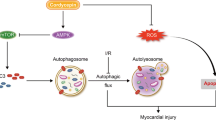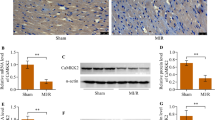Abstract
The aim of the study was to investigate the anti-apoptotic potency of TNFR:Fc gene in ischemia/reperfusion-induced myocardial cell injury and hypoxia/reoxygenation-induced H9c2 rat cardiomyocytes injury. Rats were randomly divided into the following groups (n = 8): (1) sham operation group; (2) ischemia–reperfusion (I/R) rats treated with rAAV-EGFP; (3) I/R rats treated with rAAV-TNFR:Fc group. rAAV-EGFP or rAAV-TNFR:Fc was injected intra-myocardial at four sites on the anterior and posterior walls of left ventricle immediately after the construction of I/R-induced AMI model in rats. The effects of TNFR:Fc on apoptosis and cardiacfunction were observed after 72 h of coronary reperfusion. In the in vitro study, apoptosis was analyzed in H9c2 rat cardiomyocytes treated either with nomoxia alone, or hypoxia/reoxygenation in the presence of rAAV-GFP or rAAV-TNFR:Fc. We found that (1) TNFR:Fc gene improved cardiac function (EF, LVESP, LVEDP and dp/dt max) post I/R-induced AMI; (2) TNFR:Fc gene inhibited I/R-induced apoptosis and attenuated the level of TNF-α in serum and cardiac tissue; (3) TNFR:Fc gene prevented apoptosis in hypoxia/reoxygenation-induced H9c2 rat cardiomyocytes associated with inhibition of caspase-3 activation and normalization of ratio of the Bcl-2/Bax. We concluded that TNFR:Fc gene transfection has anti-apoptotic potency in ischemia/reperfusion-induced myocardial cell injury.







Similar content being viewed by others
References
Kapur, N.K., V. Paruchuri, J.A. Urbano-Morales, E.E. Mackey, G.H. Daly, X. Qiao, N. Pandian, G. Perides, and R.H. Karas. 2013. Mechanically unloading the left ventricle before coronary reperfusion reduces left ventricular wall stress and myocardial infarct size. Circulation 128(4): 328–336.
Bryant, D., L. Becker, J. Richardson, J. Shelton, F. Franco, R. Peshock, M. Thompson, and B. Giroir. 1998. Cardiac failure in transgenic mice with myocardial expression of tumor necrosis factor-alpha. Circulation 97: 1375–1381.
Gurevitch, J., I. Frolkis, Y. Yuhas, B. Lifschitz Mercer, E. Berger, Y. Paz, M. Matsa, A. Kramer, and R. Mohr. 1997. Anti-tumor necrosis factor-alpha improves myocardial recovery after ischemia and reperfusion. Journal of the American College of Cardiology 30: 1554–1561.
Bozkurt, B., S.B. Kribbs, F.J. Clubb, L.H. Michael, V.V. Didenko, P.J. Hornsby, Y. Seta, H. Oral, F.G. Spinale, and D.L. Mann. 1998. Pathophysiologically relevant concentrations of tumor necrosis factor-α promote progressive left ventricular dysfunction and remodeling in rats. Circulation 97: 1382–1391.
Bao, C., J. Guo, M. Zheng, Y. Chen, G. Lin, and M. Hu. 2010. Enhancement of the survival of engrafted mesenchymal stem cells in the ischemic heart by TNFR gene transfection. Biochemistry and Cell Biology 88(4): 629–634.
Kubota, T., G.S. Bounoutas, M. Miyagishima, T. Kadokami, V.J. Sanders, C. Bruton, et al. 2000. Soluble tumor necrosis factor receptor abrogates myocardial inflammation but not hypertrophy in cytokine-induced cardiomyopathy. Circulation 101(21): 2518–2525.
Sugano, M., K. Tsuchida, T. Hata, and N. Makino. 2004. In vivo transfer of soluble TNF-alpha receptor 1 gene improves cardiac function and reduces infarct size after myocardial infarction in rats. FASEB Journal 18(7): 911–913.
Gurantz, D., A. Yndestad, B. Halvorsen, O.V. Lunde, J.H. Omens, T. Ueland, et al. 2005. Etanercept or intravenous immunoglobulin attenuates expression of genes involved in post-myocardial infarction remodeling. Cardiovascular Research 67(1): 106–115.
Bryant, D., L. Becker, J. Richardson, et al. 1998. Cardiac failure in transgenic mice with myocardial expression of tumor necrosis factor-alpha. Circulation 97(14): 1375–1381.
Gurevitch, J., I. Frolkis, Y. Yuhas, et al. 1997. Anti-tumor necrosis factor-alpha improves myocardial recovery after ischemia and reperfusion. JAMA 30(6): 1554–1561.
Bozkurt, B., S.B. Kribbs, F.J. Clubb, et al. 1998. Pathophysiologically relevant concentrations of tumor necrosis factor-α promote progressive left ventricular dysfunction and remodeling in rats. Circulation 97(14): 1382–1391.
Irwin, M.W., S. Mak, D.L. Mann, et al. 1999. Tissue expression and immunolocalization of tumor necrosis factor-alpha in postinfarction dysfunctional myocardium. Circulation 99(11): 1492–1498.
Akatsu, T., M. Nakamura, M. Satoh, and K. Hiramori. 2003. Increased mRNA expression of tumour necrosis factor-α and its converting enzyme in circulating leucocytes of patients with acute myocardial infarction. Clinical Science (London) 105(1): 39–44.
Song, W., X. Lu, and Q. Feng. 2000. Tumor necrosis factor-alpha induces apoptosis via inducible nitric oxide synthase in neonatal mouse cardiomyocytes. Cardiovascular Research 45(3): 595–602.
Bennett, J., D. Duan, J. Englehardt, and A.M. Maguire. 1997. Real-time non-invasive in vivo assessment of adeno-associated virus-mediated retinal transduction. Investigative Ophthalmology & Visual Science 38(13): 2857–2863.
Kaludov, N., B. Handelman, and J.A. Chiorini. 2002. Scalable purification of adeno-associated virus type 2, 4, or 5 using ion-exchange chromatography. Human Gene Therapy 13(10): 1235–1243.
Xiao, X., J. Li, and R.J. Samulski. 1996. Efficient long-term gene transfer into muscle tissue of immunocompetent mice by adeno-associated virus vector. Journal of Virology 70(11): 8098–8108.
Hutson, T.H., C. Kathe, S.C. Menezes, M.C. Rooney, H. Bueler, and L.D. Moon. 2014. The use of an adeno-associated viral vector for efficient bicistronic expression of two genes in the central nervous system. Methods in Molecular Biology 1162: 189–207.
Zaiss, A.K., Q. Liu, G.P. Bowen, N.C. Wong, J.S. Bartlett, and D.A. Muruve. 2002. Differential activation of innate immune responses by adenovirus and adeno-associated virus vectors. Journal of Virology 76(9): 4580–4590.
Acknowledgments
This project was supported by fund from Youth project of National Natural Science Foundation (81100078), the Key Project of Chinese Ministry of Education (211207), Guangzhou Pearl River science and technology new star project plan (2012 J2200063) and Guangdong Science and Technology Department (S2011040001392).
Author information
Authors and Affiliations
Corresponding authors
Rights and permissions
About this article
Cite this article
Guo, J., Zheng, D., Li, HR. et al. Anti-apoptotic Potency of TNFR:Fc Gene in Ischemia/Reperfusion-Induced Myocardial Cell Injury. Inflammation 38, 664–671 (2015). https://doi.org/10.1007/s10753-014-9975-1
Published:
Issue Date:
DOI: https://doi.org/10.1007/s10753-014-9975-1




